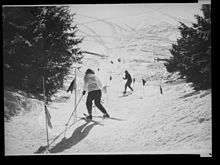Stem christie
| Skiing techniques |
|---|
|

The stem christie or wedge christie,[1] is a type of skiing turn that originated in the mid-1800s in Norway and lasted until the late 1960s.[2] It comprises three steps: 1) forming a wedge by rotating the tail of one ski outwards at an angle to the direction of movement, initiating a change in direction opposite to the stemmed ski, 2) bringing the other ski parallel to the wedged ski, and 3) completing the turn with both skis parallel as they carve an arc, sliding sideways together.[3]
History
The stem Christiana was developed by Sondre Norheim in the mid-1800s. Norheim was a Norwegian skier and inventor whose innovations included early ski heel bindings that facilitated turning and jumping, and method for turning that included the basic stem, the Christiana, stem Christiana and parallel turns.[2] The term derives from turns employed by Norwegian jumpers in Oslo, Norway—then called "Christiana"—which was later shortened to "christie".[4]
This specific type of turn was promoted in the first decade of the 1900s by
The technique was widely used until the late 1960s, when its use diminished in favor of the parallel turn,[5][6] another form of turning on skis introduced by Norheim, alongside new ideas for sidecuts (to what had earlier been parallel inside and outside ski edges).[2] Skis with increasingly parabolic sidecuts accelerated the obsolescence of the stem christie, starting in the late 1990s, because of their improved turning characteristics over skis with minimal sidecut.[7]
Further reading
- Bjaaland, Olav S. (1966). Den moderne skiidrott hundre år: 1866-1966. Oslo.
{{cite book}}: CS1 maint: location missing publisher (link) - Vaage, Jakob (1979). Skienes verden. Oslo, Norway: Hjemmenes forlag i samarbeid med Foreningen til ski-idrettens fremme. ISBN 8270061689.
- Holm, Arild, ed. (1980). Alpin skisport: utfor, slalåm, storslalåm. Sport og fritid. Oslo, Norway: Teknologisk Forlag. ISBN 8251201942. Retrieved December 29, 2021.
- Hem, Olav (1996). Idrettsordboka: norsk-engelsk/engelsk-norsk ordbok for vinteridretter. Oslo: Universitetsforlaget. ISBN 8200227758.
See also
- Snowplough turn - also known as the wedge turn or stem turn
- Parallel turn
- Skiing Topics
Notes
References
- ^ Abraham, Horst; Campbell, Stu (September 1978). Developing Skills for Skiing: Part 1. Skiing. p. 149.
- ^ Encyclopedia Britannica [EB]. Retrieved December 29, 2021.)
{{cite encyclopedia}}:|author=has generic name (help - ^ ISSN 0037-6264. Retrieved November 6, 2016.
- ^ Lund, Morten (September 2007). Norway: How it all started. International Skiing History Association. pp. 8–9.
- OCLC 1223026412.
- OCLC 975025785.
- ^ Hall, Johanna (Winter 1997). "All Mixed Up? How to Make Sense of the Multi-Shaped Lesson". PSIA.org. Archived from the original on April 11, 2003. Retrieved December 14, 2013.
{{cite web}}: CS1 maint: unfit URL (link)
